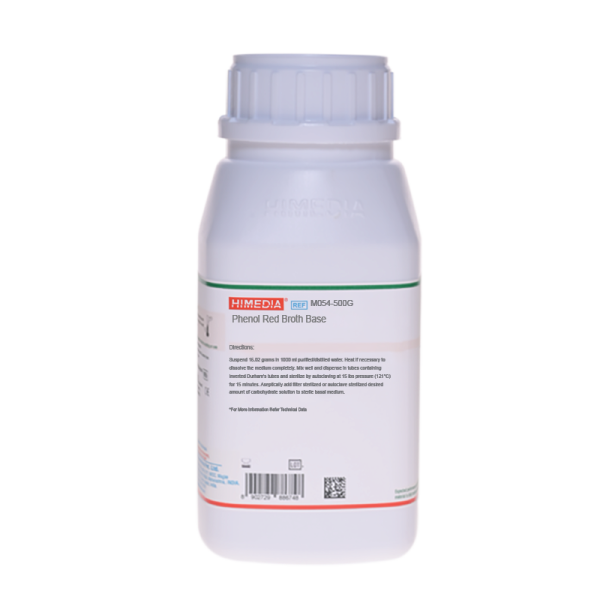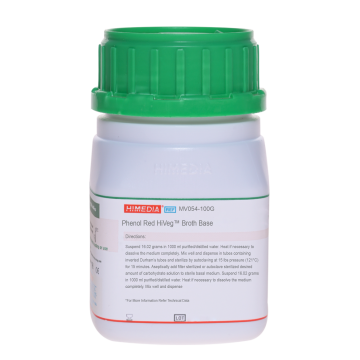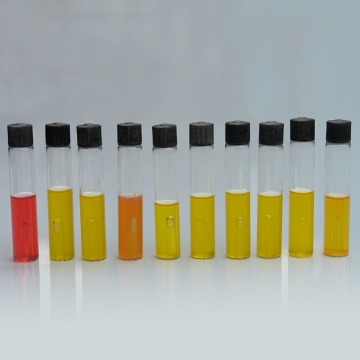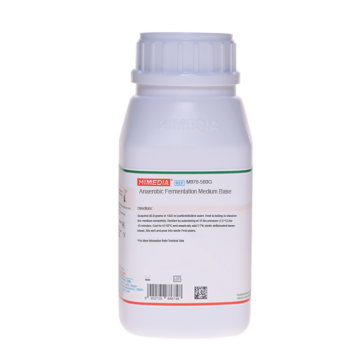 Your enquiry has been submitted
Your enquiry has been submitted
Phenol Red Broth Base
Intended Use:
A basal medium to which carbohydrates are added for determination of fermentation reactions of pure cultures of microorganisms. The composition of this medium is in accordance with FDA BAM.
Composition**
| Ingredients | g/L |
|---|---|
| Proteose peptone | 10.000 |
| HM peptone B # | 1.000 |
| Sodium chloride | 5.000 |
| Phenol red | 0.018 |
Final pH (at 25°C): 7.4±0.2
**Formula adjusted, standardized to suit performance parameters
# Equivalent to Beef extract
Directions
Suspend 16.02 grams in 1000 ml purified/distilled water,mix well. Heat if necessary to dissolve the medium completely. Mix well and dispense in fermentation tubes (tubes containing inverted Durham's tubes). Sterilize by autoclaving at 15 lbs pressure (121°C) for 15 minutes. Aseptically add filter sterilized or autoclave sterilized carbohydrate solution to sterile basal medium.
Principle And Interpretation
Phenol Red Broth Medium is formulated as per Vera (1) and is recommended to determine the fermentation reaction of carbohydrates for the differentiation of microorganisms (2-4). It is recommended by FDA BAM (5). Phenol Red Broth Medium with various added carbohydrates serves as a differential medium by aiding in differentiation of various species and genera by their ability to ferment the specific carbohydrate, with the production of acid or acid and gas (6). Phenol Red Broth Base is a complete medium without added carbohydrate, which can be used with the addition of 5-10%, desired carbohydrate. It is used as a negative control for studying fermentations or as a base for the addition of carbohydrates. Proteose peptone and HM peptone B serve as sources for carbon and nitrogen. Sodium chloride is the osmotic stabilizer. Phenol red is the pH indicator, which turns yellow at acidic pH. Gas formation is seen in Durhams tubes. All of the Enterobacteriaceae grow well in this medium. In addition to producing a pH colour shift, the production of mixed acids, notably butyric acids, often results in a pungent, foul odour from the culture medium (7).
Type of specimen
Isolated Microorganisms from clinical and non clinical sample
Specimen Collection and Handling:
For isolated Microorganisms samples follow appropriate techniques for handling specimens as per established guidelines (8,9). After use, contaminated materials must be sterilized by autoclaving before discarding.
Warning and Precautions :
In Vitro diagnostic use. For professional use only. Read the label before opening the container. Wear protective gloves/ protective clothing/eye protection/ face protection. Follow good microbiological lab practices while handling specimens and culture. Standard precautions as per established guidelines should be followed while handling specimens. Safety guidelines may be referred in individual safety data sheets.
Limitations :
- In addition to producing a pH colour shift, the production of mixed acids, notably butyric acids, often results in a pungent, foul odour from the culture medium (2).
Performance and Evaluation
Performance of the medium is expected when used as per the direction on the label within the expiry period when stored at recommended temperature.
Quality Control
Appearance Light yellow to pink coloured homogeneous free flowing powder
Colour and Clarity of prepared medium Red coloured clear solution without any precipitate
Reaction Reaction of 1.6% w/v aqueous solution at 25°C. pH : 7.4±0.2
pH 7.20-7.60
Cultural Response Cultural characteristics observed after an incubation at 35 - 37°C for 18 - 24 hours.
| Organism | without carbohydrate, (Acid) | without carbohydrate, (Gas) | with dextrose, (Acid) | with dextrose, (Gas) |
|---|---|---|---|---|
| Citrobacter freundii ATCC 8090 | Negative reaction, no colour change | Negative reaction | Positive reaction, yellow reaction colour | Positive |
| Escherichia coli ATCC 25922 (00013*) | Negative reaction, no colour change | Negative reaction | Positive reaction, yellow reaction colour | Positive |
| # Klebsiella aerogenes ATCC 13048 (00175*) | Negative reaction, no colour change | Negative reaction | Positive reaction, yellow reaction colour | Positive |
| Klebsiella pneumoniae ATCC 13883 (00097*) | Negative reaction, no colour change | Negative reaction | Positive reaction, yellow reaction colour | Positive |
| ## Proteus hauseri ATCC 13315 | Negative reaction, no colour change | Negative reaction | Positive reaction, yellow reaction colour | Positive |
| Salmonella Typhi ATCC 6539 | Negative reaction, no colour change | Negative reaction | Positive reaction, yellow reaction colour | Positive |
| Salmonella Typhimurium ATCC 14028 (00031*) | Negative reaction, no colour change | Negative reaction | Positive reaction, yellow reaction colour | Positive |
| Serratia marcescens ATCC 8100 | Negative reaction, no colour change | Negative reaction | Positive reaction, yellow reaction colour | Negative |
| Shigella flexneri ATCC 12022 (00126*) | Negative reaction, no colour change | Negative reaction | Positive reaction, yellow reaction colour | Negative |
Key : (*) Corresponding WDCM numbers,
(#) Formerly known as Enterobacter aerogenes
## Formerly known as Proteus vulgaris
Storage and Shelf Life
Store between 10-30°C in a tightly closed container and the prepared medium at 15-30°C. Use before expiry date on the label. On opening, product should be properly stored dry, after tightly capping the bottle in order to prevent lump formation due to the hygroscopic nature of the product. Improper storage of the product may lead to lump formation. Store in dry ventilated area protected from extremes of temperature and sources of ignition. Seal the container tightly after use. Product performance is best if used within stated expiry period.
Disposal
User must ensure safe disposal by autoclaving and/or incineration of used or unusable preparations of this product. Follow established laboratory procedures in disposing of infectious materials and material that comes into contact with sample must be decontaminated and disposed of in accordance with current laboratory techniques (8,9).
Reference
- Vera H. D., 1950, Am. J. Public Health, 40, 1267
- Ewing W. H., 1986, Edwards and Ewings Identification of Enterobacteriaceae, 4th ed.,Elsevier Science Publishing Co., Inc., New York.
- Finegold S. M. and Baron E. J., 1986, Bailey and Scotts Diagnostic Microbiology, 7th Ed., The C.V. Mosby Co., St. Louis.
- MacFaddin J. F., 1985, Media for Isolation-Cultivation-Identification -Maintenanceof Medical Bacteria, Vol. I, Williams and Wilkins, Baltimore.
- Bacteriological Analytical Manual, 8th Edition, Revision A, 1998.
- MacFaddin J. F., 2000, Biochemical tests for Identification of Medical Bacteria, 3rd edi., Lippincott, Williams and Wilkins, Baltimore.
- Koneman E. W., Allen S. D., Janda W.M., Schreckenberger P.C., Winn W.C. Jr., 1992, Colour Atlas and Textbook of Diagnostic Microbiology, 4th Ed., J. B. Lippinccott Company
- Isenberg, H.D. Clinical Microbiology Procedures Handbook 2nd Edition.
- Jorgensen, J.H., Pfaller, M.A., Carroll, K.C., Funke, G., Landry, M.L., Richter, S.S and Warnock., D.W. (2015) Manual of Clinical Microbiology, 11th Edition. Vol. 1.
| Product Name | Phenol Red Broth Base |
|---|---|
| SKU | M054 |
| Product Type | Regular |
| Physical Form | Powder |
| Origin | Animal |
| Packaging type | HDPE |
| References | 1. Koneman E. W., Allen S. D., Janda W.M., Schreckenberger P.C., Winn W.C. Jr., 1992, Colour Atlas and Textbook ofDiagnostic Microbiology, 4th Ed., J. B. Lippinccott Company 2.Vera H. D., 1950, Am. J. Public Health, 40, 1267 3.MacFaddin J. F., 1985, Media for Isolation-Cultivation-Identification -Maintenanceof Medical Bacteria, Vol. I, Williamsand Wilkins, Baltimore. 4.Finegold S. M. and Baron E. J., 1986, Bailey and Scotts Diagnostic Microbiology, 7th Ed., The C.V. Mosby Co., St. Louis. 5.Ewing W. H., 1986, Edwards and Ewings Identification of Enterobacteriaceae, 4th ed.,Elsevier Science Publishing Co.,Inc., New York. 6.MacFaddin J. F., 2000, Biochemical tests for Identification of Medical Bacteria, 3rd edi., Lippincott, Williams and Wilkins,Baltimore. |
| Customized Product Available | No |









